
An important part of the American Cancer Society Relay For Life is the celebration of nearly 11 million cancer survivors who are alive in the United States today. Survivors include anyone who has been diagnosed with cancer. Whether you are currently fighting your battle, or have been cancer-free for many years, you are a survivor. We also celebrate the many Caregivers who have provided countless hours of care and support.
Relay For Life is a special place for Survivors. Survivors are the main reason we continue to Relay. Survivors show us that we are making great strides in our fight against cancer, so we invite all survivors to come join us. We want to celebrate you during the opening ceremony of Relay, and invite you to walk in a special Survivors lap. If you would like to register to participate in this year's Survivor Lap & activities, please call Carol Lane at 479-216-3926. We will also honor survivors during the lighting of luminarias that shine to represent the hope for a future where cancer no longer threatens those we love.
More people are surviving cancer than ever before, and there are many reasons to celebrate. However, we know that more than 1.4 million people will be diagnosed with cancer this year and many will need a place to turn for inspiration, hope, and support. The American Cancer Society is the place to turn for help. No matter where you are in your cancer journey, The American Cancer Society offers free programs and services to help you through every step of the way. Call us anytime, day or night at 1-800-ACS-2345 (1-800-227-2345). Whether it is getting you the information you need to make treatment decisions and better understand your disease, helping you deal with the day-to-day challenges of living with cancer, such as transportation and insurance issues, or connecting you with others who have been through the cancer journey for emotional support, we are here and we can help. The many programs and services we offer are made possible by donations raised from Relay For Life events nationwide. The Polk County Relay For Life event will be held at Janssen Park in Mena on April 23-24.
Sunday, February 28, 2010
Our Survivors
Posted by Richard Lawry at 2:57 PM 0 comments
Sunday, February 21, 2010
Where Does The Money Go?

One of the questions that you are sure to be asked while trying to raise funds for Relay For Life is "what does the American Cancer Society do with the money raised". Here is a short overview of some of the things that ACS does with the money that we raise right here in Polk County along with over 5,000 other Relays in the US each year.
Since the inception of its Research Program in 1946, The American Cancer Society has contributed to almost every major cancer discovery. As a result of research advances, there are more than 10 million cancer survivors in America.
• American Cancer Society funding of select researchers led to effective treatments like chemotherapy, radiation, and bone marrow transplants that extend thousands of lives each year.
• Many cancers such as breast, cervical, colon and prostate can be detected early when treatment is more effective. Society-funded research has led to the development of early detection methods such as the PSA test and mammography.
• If colon cancer is discovered and treated early, the 5-year relative survival rate is 90%.The Society has been a leader in raising awareness about the importance of getting tested for colon cancer to save lives.
• Original American Cancer Society scientific research contributed to the recognized link between smoking and lung cancer. The Society is helping smokers double their chances of quitting through our Quitline, 1-877-YES-QUIT.
• The American Cancer Society advocates for stronger smoking ordinances and state laws to protect employees and the public from tobacco smoke in an effort to reduce death and illness caused by smoke.
• The American Cancer Society works to fund researchers early in their careers, when funding is particularly hard to receive. Remarkably, 38 of those funded researchers have gone on to win the Noble prize.
• Any time, day or night, people facing cancer can connect with lifesaving information, resources, and support online at www.cancer.org or through our toll-free call center – 1-800-ACS-2345.
• You are never alone in the Cancer Survivors NetworkSM, an online community that connects patients, survivors, and caregivers with others who have “been there” for insight, moral support, and inspiration.
• When the best hope for a cure is at a cancer center far from home, Hope Lodge® provides a comfortable, nurturing environment where patients and caregivers can stay free of charge during treatment and focus on what is most important – getting well.
• Through I Can Cope® classes, medical professionals help patients and their families overcome fears through information and resources to understand their cancer experience.
• Patients need not worry about how to get to and from their treatments when trained American Cancer Society volunteers offer free transportation, friendship, and support through our Road to Recovery® program.
• A free consultation with a Look Good … Feel Better® beauty consultant helps female patients feel beautiful again by providing tools and tips to overcome treatment side effects and restore their pre-cancer appearance and self-esteem.
• The American Cancer Society offers many other programs, services, and resources to help with the cancer journey. Call the Society to find out which ones are right for you, 1-800-ACS-2345.
• Ensured access to breast and cervical cancer screenings for low-income women.
• Continuing to restrict youth access to tobacco.
• Reduced deaths and illnesses by advocating for stronger smoking ordinances and state laws to protect employees and the public from tobacco smoke.
Posted by Richard Lawry at 10:24 AM 0 comments
Wednesday, February 10, 2010
Care For The Caregiver

If you’re like so many caregivers, you have a hard time taking time out for yourself. Not only because your time is at a premium, but also because you may feel selfish thinking about your own needs when the needs of your loved one are considerable. Your loved one is ill and needs you. And because you are not ill, you may place your own health and needs way down on your priority list. But you do so at risk not only to yourself, but your loved one, too. If you aren’t strong and healthy, you can’t be there for your loved one. So make it a priority to take care of yourself. That may be the most selfless act of all.
Taking care of you involves eating a healthy, well-balanced diet; getting regular exercise; and taking time for relaxation and rest. It also involves getting regular cancer screenings and testing. The latter may be ignored by caregivers, yet these may be the most important – especially for a caregiver who is a first-degree relative (brother, sister, or parent) of the person with cancer. Being a close relative may mean that you are at a higher risk for the same type of cancer. The best defense against most cancers is to find them as early as possible – when they are more easily treated.
Posted by Richard Lawry at 8:00 AM 0 comments
Friday, February 5, 2010
Luminaria
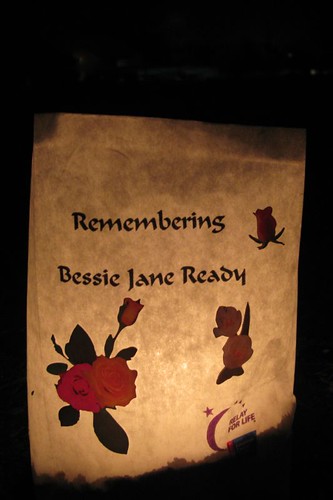
Luminaria are an important part of Relay For Life events. They are paper bags filled with sand and illuminated by a small light or candle. Each Luminaria bears the name of a person who has faced cancer, or those who have lost their battle. Each bag represents a life and story, survivor or memory – all donated in the spirit of love.
The Luminaria are placed around the track and lit as sunset approaches. As night falls it is a beautiful and poignant scene to see all the lit luminaria.
LUMINARIA LINING THE TRACK AT RELAY FOR LIFE
There is a Luminaria Ceremony that offers everyone at Relay the opportunity to honor and remember those whose lives have been touched by cancer. Luminaria also raise money for Relay For Life.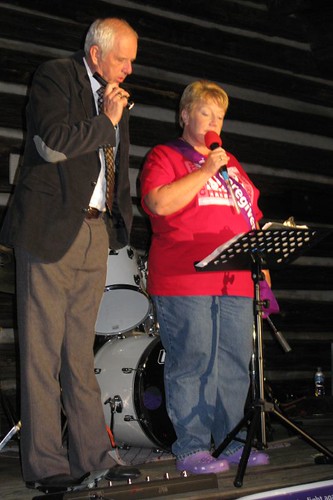
REGINA LAWRY AND JIM HUFF AT LUMINARIA CEREMONY
A special Luminaria Ceremony will be held during the Polk County Relay For Life to be held April 23rd at Janssen Park in Mena. During the ceremony we will remember those lost to cancer and honor those who have survived. Luminaria will be lit at sundown to represent these individuals.
Anyone desiring to make a luminaria donation may do so by contacting Relay For Life team members. Each luminaria candle is $5.00. Each luminaria represents the life of someone who has battled cancer. It is a beautiful sight when all the bags with candles are illuminated around the track. The Luminaria Ceremony is a moving way to remember loved ones lost to cancer and to pay tribute to cancer survivors.”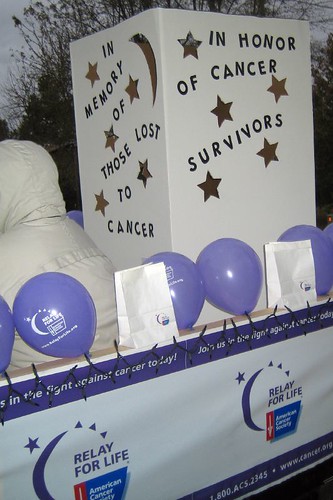
THE REFRIGERATOR BOX LUMINARIA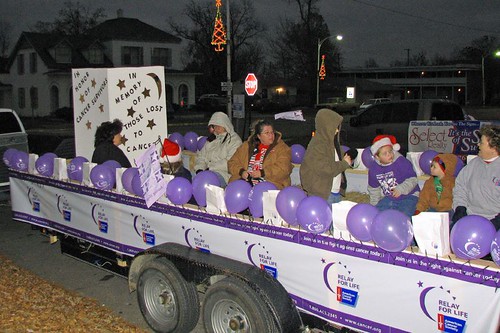
RELAY FOR LIFE FLOAT IN THE PARADE
If you have never been involved in a Relay For Life, find out if there is one in your community and become a part of it. In 2009 there were over 5,000 Relay For Life events with 3.5 million people participating. Don't miss out on the fun of this important event. Last year over 400 million dollars was raised by Relay For Life for cancer research, education, advocacy and service. 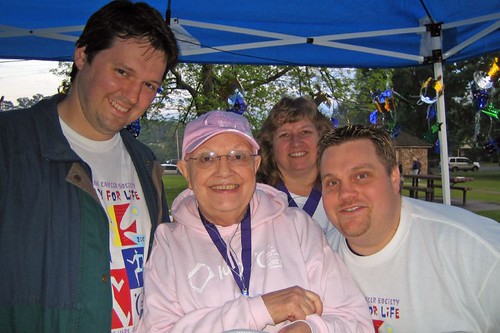
RELAY FOR LIFE IS FUN AND FULFILLING
Posted by Richard Lawry at 7:25 PM 0 comments
Wednesday, February 3, 2010
How Relay For Life Got Started

Relay For Life is a life-changing event that brings together more than 3.5 million people to:
• Celebrate the lives of those who have battled cancer. The strength of survivors inspires others to continue to fight.
• Remember loved ones lost to the disease. At Relay, people who have walked alongside people battling cancer can grieve and find healing.
• Fight Back. We Relay because we have been touched by cancer and desperately want to put an end to the disease.
One person can make a difference. Nowhere is that more evident than with the story of the American Cancer Society Relay For Life, which began in Tacoma, Washington. In the mid-1980s, Dr. Gordy Klatt, a Tacoma colorectal surgeon, wanted to enhance the income of his local American Cancer Society office and to show support for all of his patients who had battled cancer. He decided to personally raise money for the fight by doing something he enjoyed – running marathons.
In May 1985, Dr. Klatt spent a grueling 24 hours circling the track at Baker Stadium at the University of Puget Sound in Tacoma. He ran for more than 83 miles. That first year, nearly 300 of Dr. Klatt's friends, family, and patients watched as he ran and walked the course. Throughout the night, friends donated $25 to run or walk with Dr. Klatt for 30 minutes. His efforts raised $27,000 to fight cancer.
While circling the track those 24 hours, Dr. Klatt thought about how others could take part in his mission to fight cancer. He envisioned a 24-hour team relay event that could raise more money to fight cancer. Over the next few months, he pulled together a small committee to plan the first team relay event, known as the City of Destiny Classic 24-Hour Run Against Cancer.
In 1986, with the help of Pat Flynn – now known as the “Mother of Relay” – 19 teams took part in the first team Relay event on the track at the historic Stadium Bowl and raised $33,000. An indescribable spirit prevailed at the track and in the tents that dotted the infield.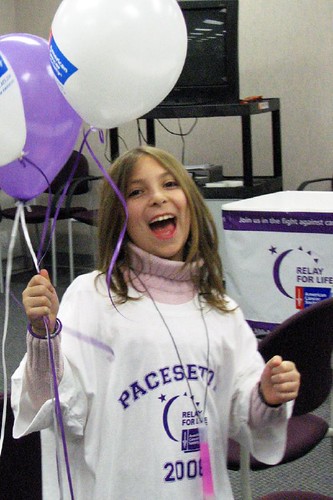
In 2010 there will be Relay For Life events in over 5,000 communities. Check and see if you community is one of them, and if it is plan to participate.
Posted by Richard Lawry at 7:35 AM 0 comments
Monday, February 1, 2010
Childhood Cancer

The types of cancers that occur in children vary greatly from those seen in adults. Leukemias, brain and other nervous system tumors, lymphomas (lymph tissue cancers), bone cancers, soft tissue sarcomas, kidney cancers, eye cancers, and adrenal gland cancers are the most common cancers of children.
Leukemias are the most common childhood cancers. They account for about 33% of all childhood cancers.
Although there are exceptions, childhood cancers tend to respond better to chemotherapy. Children also tolerate chemotherapy better than adults. But, because chemotherapy can have some long-term side effects, children who survive their cancer need careful attention for the rest of their lives.
About 10,730 children under the age of 15 in the United States were expected to be diagnosed with cancer in 2008. Because of significant advances in treatment, 80% of these children will survive 5 years or more. This is a major increase from before the 1970s, when the 5-year survival rate was less than 50%.
Posted by Richard Lawry at 8:39 PM 0 comments




